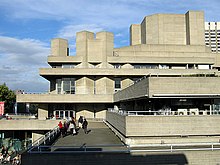Denys Lasdun

Sir Denys Louis Lasdun,
Lasdun studied at the
Family
Lasdun's grandfather, the Australia-based tobacconist Louis Abrahams (1852–1903), was an important patron of Frederick McCubbin, Arthur Streeton and other artists associated with the Heidelberg School art movement, also known as Australian Impressionism. His art collection was passed down to Lasdun.[5] His mother Julie Lasdun was a pianist who accompanied the Hungarian violinist Adila Fachiri.[6] In 1930 she played in the first chamber performance of Constant Lambert's The Rio Grande, alongside Arthur Benjamin.[7] The Royal College of Music commemorated her through the Julie Lasdun Prize.[8]
Lasdun married Susan Bendit in 1954 and there were two sons and a daughter.[9] One is the author James Lasdun.[10]
Early work

Before and after
In the 1950s he was a partner with

Lasdun completed what may be regarded as his breakthrough masterwork in the
University buildings

Elements of Lasdun's most famous style, which combined cubic towers, bare concrete and jutting foyers, which was compared by some to
Late work

The most celebrated of the architect's work is his Royal National Theatre on London's South Bank. King Charles compared it to a nuclear power station but it was popular with other traditionalists, with John Betjeman writing Lasdun a letter in praise of its design. Lasdun (or his firm Lasdun, Softley and Partners) designed the neighbouring IBM headquarters (finished 1985) as a low-rise setting for the theatre. His European Investment Bank in Luxembourg deployed a similar layered low-rise design approach. The last works produced by the firm were an office block, Milton Gate, Chiswell Street, London clad in green-tinted glazing and 10 Fenchurch Street, London clad in aluminium; Lasdun's design involvement with these was very slight.
Lasdun was awarded the RIBA Royal Gold Medal in 1977. His drawings and papers are available for consultation at the RIBA Drawings & Archives Collections. Despite the controversy of much of his work, most of Lasdun's surviving buildings are listed, although his 1958 Peter Robinson department store on London's Strand was demolished in the 1990s.
Lasdun died on 11 January 2001 aged 86.
National Life Stories conducted an oral history interview (C467/9) with Denys Lasdun in 1996-97 for its Architects Lives' collection held by the British Library.[14]
Projects

- House for Self, 32 Newton Road, London W2 (1938) listed Grade II
- Hallfield Primary School, Hallfield Estate,Paddington, London (1952), Grade II* listed
- Keeling House, Claredale House (Grade II* listed: the first example of post-war council housing to gain this distinction)
- Bradley House, Usk Street, a smaller variation of the Keeling House design, unlisted Bethnal Green (1957)
- Peter Robinson department store and offices over, Strand, London (1958) (demolished).
- Castlemaine House, London, (1959–60)
- 26 St James's Place, luxury residential, London, (1959–60)
- Fitzwilliam College, Cambridge (1959–63)
- Grade I listed
- The core buildings of the University of East Anglia, Norwich (1962–68), including residential ziggurats, spine blocks, library etc.
- University Sports Centre, Oxford Road, Liverpool, England (1963)
- House for self - conversion, Rowan Rd, London.
- The Charles Wilson building at the University of Leicester
- The Lasdun Building, a residential block located in Stamford Hall, at the University of Leicester
- School of Oriental and African Studies, Bloomsbury
- New Court, Christ's College, Cambridge (1966–70)
- Grade II* listed
- The first phase of the European Investment Bank, Bvd. Konrad Adenauer,Luxembourg (1974–80)
- IBM Building, South Bank, London (1979–83)
References
- ^ Diana Rowntree (12 January 2001). "Obituary: Sir Denys Lasdun | News". The Guardian. London. Retrieved 22 October 2013.
- ^ "findmypast.co.uk". search.findmypast.co.uk. Retrieved 4 February 2018.
- ^ "findmypast.co.uk". search.findmypast.co.uk. Retrieved 4 February 2018.
- ^ "Sir Denys Lasdun | Artist | Royal Academy of Arts". www.royalacademy.org.uk. Retrieved 29 January 2020.
- ^ "One of the greatest early patrons of Australian art" (12 December 2017), Christie's. Retrieved 31 July 2018.
- ^ Joseph Macleod. The Sisters d' Aranyi (2021)
- ^ Lloyd, Stephen. Beyond the Rio Grande (2014), p. 120-1
- ^ Register of Charities
- ^ 'Forthcoming Marriages, The Times, 23 March 1954, p.10
- ^ [1] Book review by Jenny Turner in The Guardian
- ^ "Architecture". rcplondon.ac.uk. 15 January 2015. Retrieved 4 February 2018.
- ^ England, Historic. "ROYAL COLLEGE OF PHYSICIANS, Camden - 1246159- Historic England". historicengland.org.uk. Retrieved 4 February 2018.
- ^ "The anatomy of a building: Denys Lasdun and the Royal College of Physicians". rcplondon.ac.uk. 8 September 2014. Retrieved 4 February 2018.
- ^ National Life Stories, 'Lasdunm Denys (1 of 10) National Life Stories Collection: Architects' Lives', The British Library Board, 1997. Retrieved 10 April 2018
- The Legacy of Lasdun
- Oxford Dictionary of National Biography
- William J. R. Curtis, Denys Lasdun: Architecture, City, Landscape (Phaidon, 1994)
- Barnabas Calder, "The Education of an Architect: Denys Lasdun in the 1930s" in British Modern (2007)
- Inspiring physicians biography
